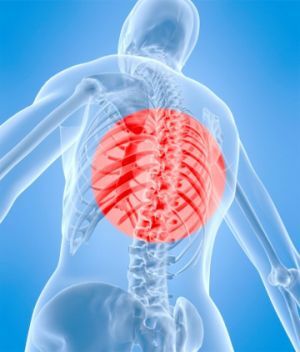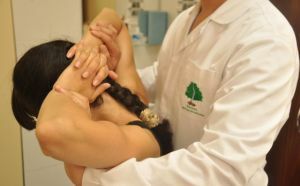 Thoracalgia is the chest pain , which occurs when the intercostal nerves are compressed or irritated, or when they are affected by viruses and some other factors.
Thoracalgia is the chest pain , which occurs when the intercostal nerves are compressed or irritated, or when they are affected by viruses and some other factors.
Attacks of pain arise due to muscle spasm caused by irritation of the affected nerve. Substrate for thoracalgia may be lesions of spinal ganglia, peripheral nerves, spinal cord membranes, intervertebral discs, muscles, joints, ligaments and fascia.
Sometimes these pains are treated as psychogenic.
Article Contents
- Torakalgiya - you need to know
- Vertebrogenous variant syndrome
- reasons that cause
- Symptoms of the disease syndrome
- main symptoms
- Related
- symptoms Treatments
- Pharmacotherapy
- Physiotherapy and massage
Torakalgiya - you need to know

Vertebrogenic and vertebral torakalgiya -chest pain
Thoracalgia( ICD code 10 - M54.6.) - a disease of the peripheral nerves, accompanied by severe pain. Violation of thoracalgia, as a pain in the sternum, in. ..
Vertebrogenic version of the
syndrome Vertebrogenic( discogenic) thoracology, referred to in the ICD10, is the most common variant of this pain syndrome. Its peculiarity consists in the fact that it arises in diseases of the spine, for example, in the lesion of intervertebral discs.
There are four clinical types of vertebrogenic disease:
- Pains with functional disorders of the lower part of the cervical spine .In this case, the pain in the upper chest, radiating to the shoulder, neck and whole arm.
- Pain arising from disorders of the upper thoracic part of the spine. Spilled, prolonged chest pains, pains in the interblade area, difficulty in breathing are characteristic.
- Painful attacks with lesions of the scapular region. Characterized by a variety of pain: stitching, cutting, blunt, acute, prolonged or short-term. Often localized pain in the interblade area, occurs when inhaling and exhaling, sometimes irradiates along the intercostal nerves.
- Pain sensations occur with compression of the anterior thoracic wall .In this case, the pain is long, aching, localized near the sternum and worse when performing movements.
Causes of
Syndrome Osteochondrosis, herniated discs, scoliosis often cause chest pain, other diseases are much less common. 
Osteochondrosis is the leader in the list, as it leads to a decrease in the height of the intervertebral discs, which in turn leads to a decrease in the height of the intervertebral canals and an increase in the probability of infringement.
Pain can be localized to the left or right of the spine, which indicates the infringement of the specific roots of the spinal cord. More common is right-sided localization.
The causes of vertebrogenic thoracalgia are:
- osteochondrosis, disc protrusions, intervertebral hernia of the cervical or thoracic region;
- scoliosis, lordosis, kyphosis;
- spinal injury;
- Scheuerman-Mau disease;
- functional disorders of the facet joints of the thoracic region.
Osteochondrosis manifests as aching dull pain, which is characterized by so-called "lumbago".Intervertebral hernia is a complication of osteochondrosis.
For example, increased blood pressure, in the absence of any heart disease.
Among vertebral injuries, the leading role is played by vertebral fractures when falling from a height, impact, etc. The disease of Sheyerman-Mau is characterized by a violation of the process of vertebral formation in childhood and adolescence.
Symptoms of the disease
The disease has simple symptoms. Therefore, diagnose this state can be quite quickly and correctly. It is accepted to identify the main and accompanying symptoms.
The main symptoms of
The leading clinical manifestation of is the persistent pain syndrome in the spine. 
There is a violation of posture, deformation of the spine, sometimes - restriction of movements in the appropriate department. There is a shortening of the trunk, a decrease in growth of 10-15 centimeters. The distance between the ribs and the pelvic bones decreases.
There is pain in the palpation of the spine, which is associated with a weakening of the osteo-ligament apparatus, as well as spasm of the muscular apparatus.
Pain usually has a burning character, spreads along the intercostal spaces, is localized on one side or has a shingling character. Painful sensations are intensified by sudden movements, sneezing, coughing.
The hearth is usually located along the nerve and is easily palpable. There is a violation of the sensitivity of the skin in the area innervated by the affected spine roots. With vertebrogenic thoracalgia, there is a so-called muscular defens - the tension of the muscles of the back and neck.
Concomitant symptoms
When movements occur, vertebrae crunch occurs. The patient feels discomfort, it seems to him that creeps creep in the interblade area.
The above symptoms may be worse when exposed to cold temperatures, with prolonged stay in one position.
 What if the hip joint contracture manifested after the forced immobilization of the joint? The answer can be found in our material.
What if the hip joint contracture manifested after the forced immobilization of the joint? The answer can be found in our material.
Back pain or chronic vertebrogenic lumboscialgia is no less an unpleasant disease than vertebrogenic thoracalgia. About the features of these pains read here.
Treatment procedures
At this stage there is no quick and effective treatment that can save the patient from this ailment. This is due to the localization of the process.
Under optimal conditions, success in the treatment of vertebrogenic thoracalgia can be expected already in the first month of taking medications.
Otherwise, treatment is delayed. For a good effect, you need to combine medical therapy with physiotherapy, in particular with special massages and therapeutic gymnastics.
Spinal traction is rarely used, but recently this method is often challenged. To reduce the pain, you can refer to acupuncture.
Medical treatment
Most often, a neurologist prescribes treatment with such drugs:
- anti-inflammatory drugs( meloxicam, diclofenac);
- muscle relaxants( baclosan, midokalm, sirdalud);
- neuroprotectors( thioctic acid);
- vitamins of group B.
Physiotherapy and massage
 To improve the effect, special procedures are included in the treatment regimen. The patient should not give up such an opportunity, as these procedures contribute to a quick recovery and the consolidation of the effect.
To improve the effect, special procedures are included in the treatment regimen. The patient should not give up such an opportunity, as these procedures contribute to a quick recovery and the consolidation of the effect.
It is necessary to carry out the procedures in a complex, ending each session with a massage, which is aimed at working with the scapular muscles and the paravertebral zone of the thoracic region.
Before taking a course of drug therapy, it is not recommended to do therapeutic exercises. Massages increase blood circulation to the damaged root, which leads to an increase in edema and aggravation of the condition.
Therefore, it is necessary to undergo a course of treatment, and then resort to physiotherapy.
Vertebrogenic thoracology is an condition requiring attention from the patient .With timely detection and correct, comprehensive treatment, you can, without losing the quality of life, deal with this problem.
In case of symptoms, it is necessary to contact a specialist for diagnosis and the appointment of an individual treatment.



